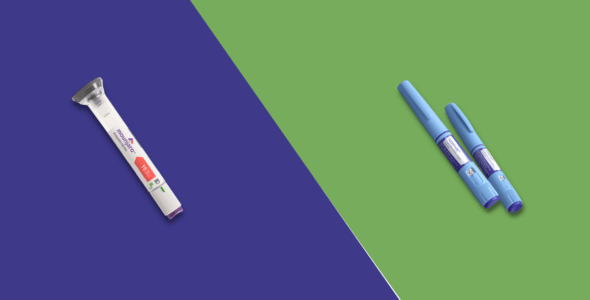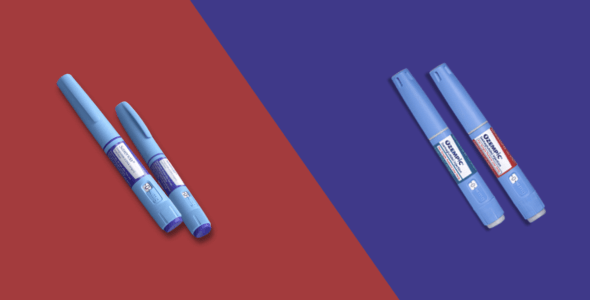Saxenda alternatives for weight loss
Table of contents
Saxenda is an FDA-approved (U.S. Food and Drug Administration) brand-name medication manufactured by Novo Nordisk Inc. It is classed as a glucagon-like peptide-1 receptor agonist and has been used to treat diabetes, and is FDA-approved for weight loss.
Learn more about Saxenda, what it’s used for, its side effects, interactions, the precautions you should take when using it, and the alternative treatments available.
What is Saxenda?
Saxenda contains liraglutide as the active ingredient. Liraglutide is similar to a naturally occurring hormone that controls digestion, insulin levels, and blood glucose levels. Saxenda is recommended alongside a reduced-calorie diet and an increase in exercise. It is used to help manage obesity in adult patients with a body mass index (BMI) of:
- 30 kg/m2 or more, or
- 27 kg/m2 or more with a weight-related condition such as high blood pressure, type 2 diabetes, high cholesterol, triglycerides, or a low HDL cholesterol level that is making plaque build-up in your arteries worse
Saxenda is not specifically for the treatment of type 1 or type 2 diabetes or weight loss. Saxenda is part of a treatment plan that will include diet, exercise, and weight management. GLP-1 is classed as a physiological regulator of appetite and calorie intake. This means it works by a method known as negative feedback.
RELATED: What is Saxenda
Is Saxenda an appetite suppressant?
Saxenda works by suppressing your appetite by increasing the feeling of being full and reducing the sense of hunger in your brain. This leads to a reduction in eating and consuming fewer calories and losing weight.
Does Saxenda help with diabetes?
Yes, when Saxenda is used in combination with diet and exercise, it has been shown to be effective in preventing the development of type 2 diabetes.
What are the side effects of Saxenda?
The most common side effects of Saxenda in clinical trials include:
- Gastrointestinal side effects – indigestion, nausea, vomiting, abdominal pain, diarrhea, constipation
- Injection site reactions
- Fast heart rate
- Tiredness
- Headaches and dizziness
More serious side effects of Saxenda include:
- Increased heart rate
- Suicidal thoughts or sudden changes in behavior and mood
- Severe nausea, vomiting, or diarrhea that will not stop
- Hypoglycemia (very low blood sugar levels) – feeling very weak, shaking, confused, sweating, fainting, or seizures
- Pain or difficulty urinating, swelling in ankles or feet, tiredness, and difficulty breathing
- Trouble swallowing, lump, or swollen neck
- Jaundice – yellowing of eyes or skin, darker stools, upper stomach pain spreading to the back
- Increased risk of thyroid cancer or tumors
- Pancreatitis (inflammation of the pancreas)
You are encouraged to report the negative side effects of prescription drugs to the FDA. Visit www.fda.gov/medwatch, or call 1-800-FDA-1088.
Saxenda dosage
Saxenda is available in injection form at 6 mg/mL and delivers the following doses: 0.6 mg, 1.2 mg, 1.8 mg, 2.4 mg or 3 mg.
Liraglutide is classed as an acylated human glucagon-like peptide-1/GLP-1 receptor agonist. Liraglutide binds to and activates the GLP-1 receptor. Unlike naturally occurring GLP-1 in the body, which has a half-life of up to 2 minutes, liraglutide is stable against breakdown by enzymes in the body and has a half-life of 13 hours.
Saxenda is given as a subcutaneous injection under the skin. It can be given at any time of the day, with or without a meal. You should not inject it into the same place two times in a row.
You are advised to read the medication guide provided with this medicine for the drug information and patient information, and always speak with your healthcare provider for medical advice about any changes to your dose so they can monitor and evaluate your condition.
RELATED: Saxenda Dosage
What medication is similar to Saxenda?
Medications similar to Saxenda include:
- Ozempic (semaglutide)
- Trulicity (dulaglutide)
- Wegovy (semaglutide)
- Compounded Semaglutide injection
- Compounded Tirzepatide injection
These medications contain active ingredients that belong to the same class of drugs (glucagon-like peptide-1 receptor agonist) as the active ingredient in Saxenda.
Natural alternative to Saxenda
Natural alternatives to Saxenda for weight loss that are safe and proven to be effective will involve changes to your lifestyle. This will include having a healthy diet and maintaining a good level of physical activity. Both of these will help with weight loss and are especially beneficial if you are suffering from obesity. Speak to your healthcare provider or a dietitian for advice on what foods to eat and which to avoid.
Supplements are another natural alternative that may have beneficial effects for the purposes of weight loss. This, however, needs further investigation as the results of using supplements to aid weight loss are not conclusive.
Wegovy vs Saxenda
Wegovy is also an FDA-approved weight loss medication manufactured by Novo Nordisk and is also a glucagon-like peptide-1 receptor agonist indicated as an adjunct to a reduced-calorie diet and increased physical activity for chronic weight management in adult patients.
The active ingredient in Wegovy, semaglutide, acts in the same way as GLP-1 incretin hormones. By stimulating the same receptors, it causes your body to release more insulin and less glucagon and digest food slower.
Wegovy is available in a prefilled injection form in the following doses: 0.25 mg, 0.5 mg, 1 mg, 1.7 mg, or 2.4 mg. Wegovy should be injected subcutaneously once weekly, on the same day each week, at any time of day, with or without meals, due to its 7-day elimination half-life.
As Wegovy and Saxenda belong to the same class of drugs, their side effects, drug interactions, and warnings and precautions are the same.
RELATED: Wegovy vs Saxenda
What is better than Saxenda for weight loss?
Wegovy injections have been found to be more effective for weight loss than Saxenda. A 2018 study carried out over a year compared weight loss with semaglutide injections, liraglutide injections, and placebo. Participants received daily doses of semaglutide, liraglutide, or a placebo injection. Semaglutide was given in daily doses rather than weekly doses in this trial. At week 52, the average weight loss with those given semaglutide injections was 11.2-13.8% of their starting body weight, whereas liraglutide participants lost around 7-8%.
Wegovy produces better weight loss and cardiovascular outcomes, but it is important to know that this shouldn’t be your only deciding factor when choosing between medications. The final decision on your treatment is down to your prescriber, alongside a discussion with you. Both medicines work in a very similar way within the body, but you should seek medical advice from your healthcare professional about which of these weight loss drugs would be best for you based on your medical conditions and your current medication, including any over-the-counter meds and supplements.
What is the difference between Saxenda and Victoza?
Saxenda and Victoza are both injectable medications containing liraglutide. Both are available in similar, pre-filled, multi-dose pens that deliver doses of 0.6 mg, 1.2 mg, and 1.8 mg. Saxenda is also available in pre-filled, multi-dose pens that deliver doses of 2.4 mg or 3 mg. The only difference between these two medications is the conditions they are approved to be used for by the FDA. Saxenda is used in combination with a reduced-calorie diet and increased physical activity for chronic weight management, while Victoza is used in combination with diet and exercise to improve glycemic control in patients 10 years of age and older with type 2 diabetes or to reduce the risk of major adverse cardiovascular events in adults with type 2 diabetes with cardiovascular disease.
RELATED: Saxenda vs Victoza
Is there a cheaper alternative to Saxenda?
Ozempic is the cheapest alternative to Saxenda. The average monthly cost for Ozempic is around $700, while the average monthly cost for Saxenda when you first start using it is around $1000 (your dose of Saxenda will increase as you use it, and so will your monthly cost). Currently, however, Ozempic is not FDA-approved for weight loss, but you may lose weight when using it to treat type 2 diabetes. Ozempic is under review to be used for weight loss in combination with exercise and diet.
RELATED: Saxenda vs Ozempic
How do you get Saxenda at an affordable price?
Saxenda prices without insurance will vary depending on how much you buy and where you buy it. The cost of Saxenda with insurance will depend on the terms of your healthcare plan. Your healthcare provider or pharmacist will be able to calculate your copay with your current insurance. Contact them to find out more.
Is there a generic version of Saxenda?
Unfortunately, Saxenda is only available as a brand-name medication. It’s not available in a generic form.
Saxenda drug interactions
Saxenda can interact with other medications. This can change how Saxenda and other medications work and make side effects more likely. Tell your prescribing physician about all your drugs, including vitamins and dietary supplements.
Saxenda may interact with other medications, such as antibiotics, and other diabetic treatments, such as insulin or sulfonylureas, antivirals, diuretics, and corticosteroids.
Saxenda warnings & precautions
You should not use Saxenda if you:
- Are allergic to the active ingredient liraglutide
- Have had an allergic reaction to any of the other ingredients in Saxenda
- Are using insulin or albiglutide, dulaglutide, or exenatide
- Have multiple endocrine neoplasia syndrome type 2 (MEN 2)
- Have a family history of medullary thyroid carcinoma
- Have diabetic ketoacidosis
- Are under 18 years of age
Talk to your doctor before using Saxenda if you:
- Are taking any of the medications that could interact with Saxenda
- Have kidney disease
- Have liver disease
- Have high cholesterol or triglycerides
- Have heart problems
- Have problems with your pancreas or gallbladder
- Have depression or suicidal thoughts
- Have stomach or digestion problems
- Are pregnant or are planning to become pregnant
- Are breastfeeding or are planning to breastfeed
You should always check with your doctor or pharmacist before taking any medication, including Saxenda, to make sure it is safe for you.
Is it safe to take Saxenda if I am pregnant?
Saxenda is not recommended for use during pregnancy, and if a patient is planning to become pregnant, treatment with Saxenda should be stopped because weight loss is of no benefit to a pregnant woman and may cause fetal harm.
Medically reviewed
A medical professional has reviewed this article.


Jamie Winn, PharmD
Jamie Winn, PharmD
Dr. Jamie Winn received his Doctor of Pharmacy in 2002 from the University of South Carolina College of Pharmacy, Columbia, SC. Jamie is a medical reviewer for NiceRx.





